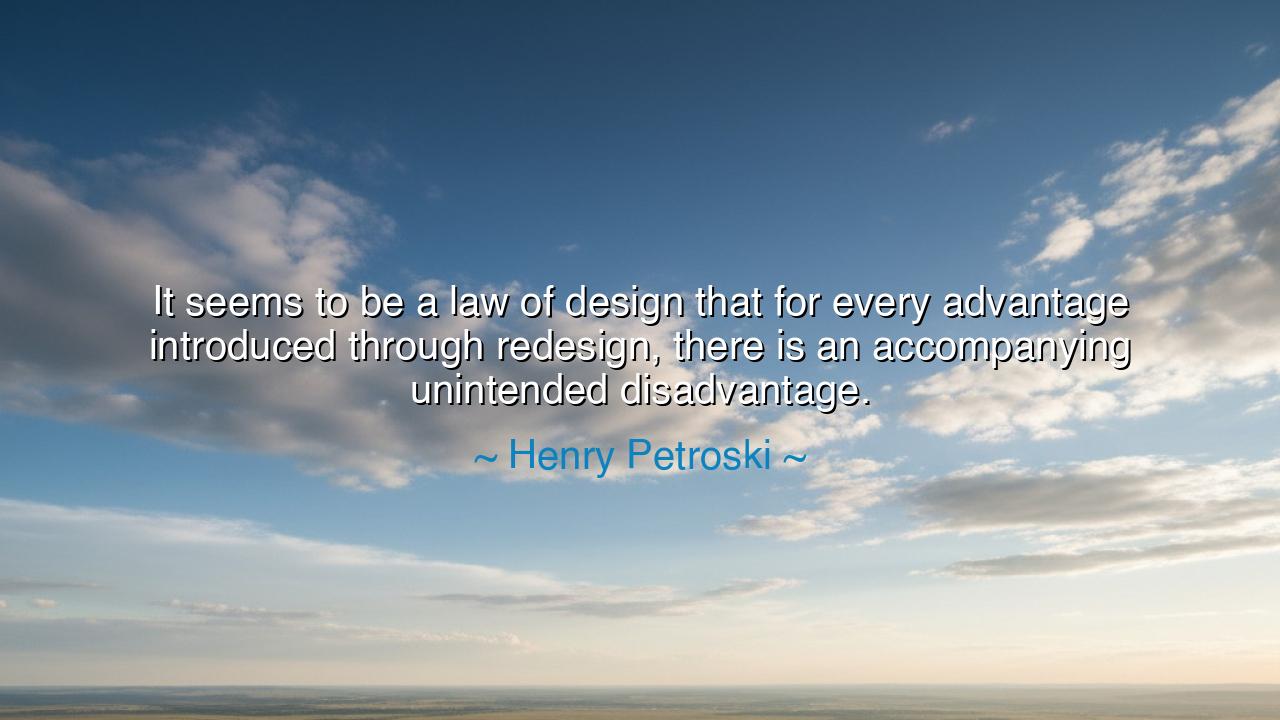
It seems to be a law of design that for every advantage
It seems to be a law of design that for every advantage introduced through redesign, there is an accompanying unintended disadvantage.






“It seems to be a law of design that for every advantage introduced through redesign, there is an accompanying unintended disadvantage,” wrote Henry Petroski, the great engineer-philosopher who saw in every bridge, every tool, every invention, not only triumph but tragedy, not only progress but peril. His words carry the weight of millennia, for they speak not only of engineering but of the eternal balance between creation and consequence. In them lies the wisdom of ages: that nothing born of human hands is without shadow, that every new form brings both light and burden, and that perfection, in this mortal world, is but an illusion chasing itself in circles.
Petroski’s reflection arises from the heart of his craft—the study of design, of how humanity seeks to shape the world to its will. He understood that in the quest to improve, to refine, to innovate, we often sow the seeds of new imperfection. The sharper the blade, the greater the danger of the cut; the faster the machine, the more terrible the crash when it fails. This is not a curse but a law of nature—for with every gain in power comes an increase in complexity, and with complexity, the specter of fragility. Thus, Petroski’s “law of design” stands not as a lament but as a warning: that all creation demands humility, and all progress must be tempered by foresight.
To understand his meaning, we may look to the story of the Titanic, the so-called “unsinkable ship.” Its design was hailed as a marvel of human ingenuity—a vessel so advanced, so masterfully built, that it was thought to defy nature itself. Yet it was this very confidence, born from redesign and innovation, that blinded its creators to the unforeseen—the absence of sufficient lifeboats, the arrogance of speed, the ignorance of ice. In seeking perfection, they had introduced imperfection in disguise. The Titanic’s sinking was not only a tragedy of ice and ocean but a lesson in the law of unintended consequences, the very truth Petroski reminds us never to forget.
This law reaches far beyond ships and steel. When man split the atom to harness the power of the sun, he dreamed of endless energy—but also opened the gates to destruction. When the internet was born to connect the world, it also gave rise to disconnection of another kind—isolation within noise, and the loss of quiet thought. Even in medicine, the cure for one illness may awaken another. Thus, in every redesign, there lies duality: creation and destruction, benefit and burden, order and chaos. Petroski calls us not to despair, but to wisdom—to recognize that progress, like fire, is sacred only when handled with care.
The ancients, too, knew this truth well. The Greeks told of Icarus, who fashioned wings from wax and feathers. His design was magnificent—a triumph of imagination—but in his ascent toward the sun, he forgot the fragility of his creation. His wings melted, and he fell into the sea. The myth is not a tale against invention, but against hubris—the failure to foresee the unintended disadvantage that comes with every newfound power. It teaches us, as Petroski does, that design is not merely about achieving greatness, but about understanding the limits of greatness itself.
In these words we find a call for balance. To design wisely is not to avoid risk, but to acknowledge it; not to shun innovation, but to temper it with reflection. Petroski’s insight reminds every creator—engineer, artist, leader, or dreamer—that the act of making must be accompanied by the act of questioning. Every improvement must ask, “What might this cost?” Every new form must bow before the eternal law: that nothing comes without trade, and that to design is to accept responsibility for what follows.
Therefore, let this teaching be remembered by all who seek to build, whether in material or in spirit: do not worship innovation blindly, but treat it as sacred fire. For progress without wisdom is destruction wearing a crown, and invention without humility becomes its own undoing. As Petroski teaches, every advance must be measured not only by what it achieves, but by what it risks. The wise creator looks upon their work and sees both its promise and its peril, both its advantage and its flaw—and still, with steady heart, dares to continue.
So let us design with courage, but also with reverence. Let us build bridges, but remember the rivers they cross; let us shape tools, but honor the hands that wield them. For the law of design is not meant to halt us, but to humble us—to remind us that perfection lies not in erasing flaw, but in understanding it. In this balance of creation and caution, humanity finds its truest form—not the gods we dream to be, but the caretakers we are meant to become.






AAdministratorAdministrator
Welcome, honored guests. Please leave a comment, we will respond soon